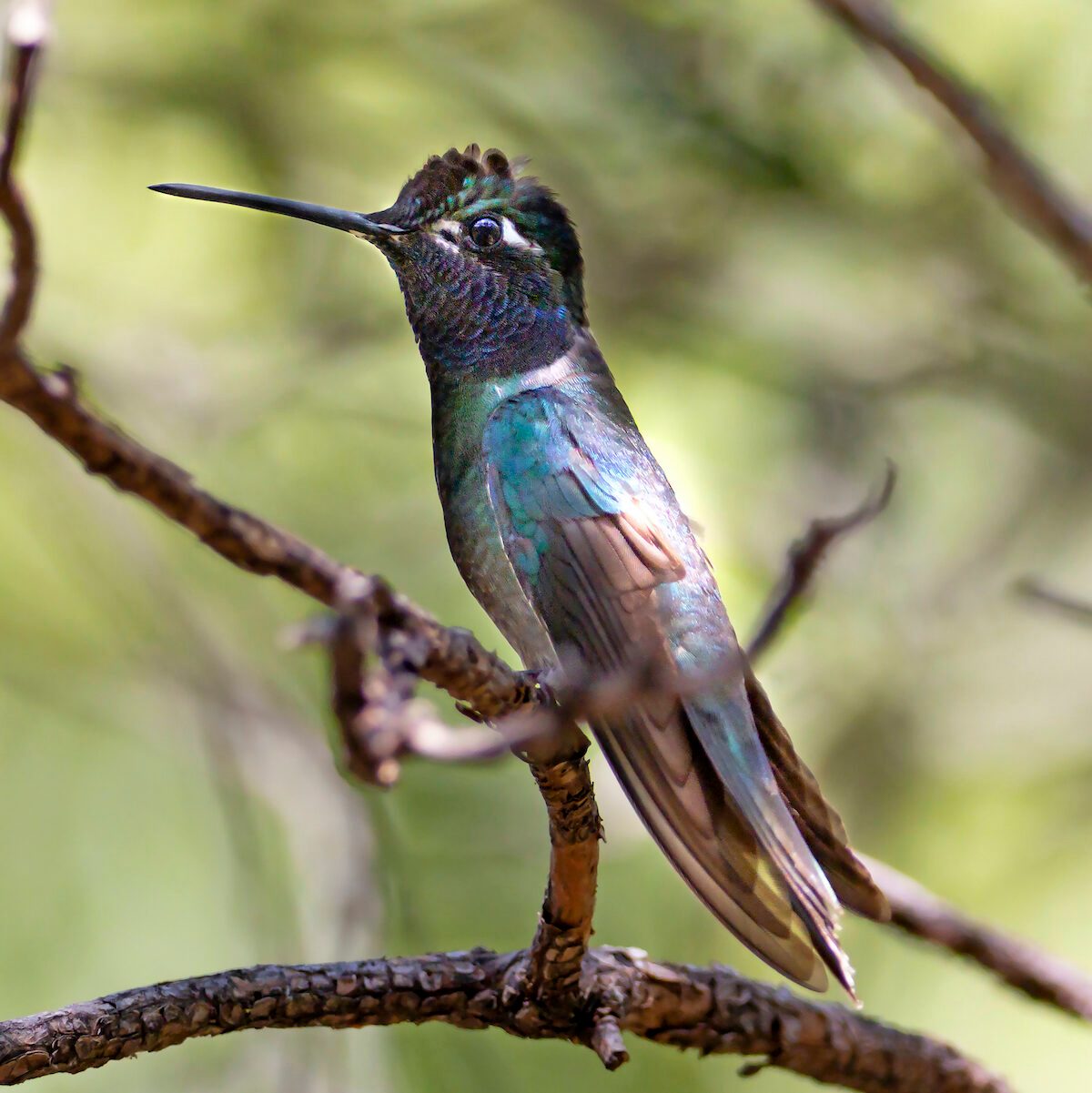The Rivoli's hummingbird is a striking, shimmery flier. Learn how to identify these gorgeous birds and why their name was changed... twice!

Meet the Magnificent Rivoli’s Hummingbird

On This Page
What Does a Rivoli’s Hummingbird Look Like?

An adult male Rivoli’s hummingbird has that classic hummingbird shimmer, but they’re even more dazzling than many of the other types of hummingbirds in the United States. A teal green gorget and purplish feathers on the crowns of their heads are a surefire way to identify a male. The feathers on his back might appear black, but take a closer look—they’re an iridescent dark green.

Telling a female Rivoli’s apart from other species is a bit trickier. At first glance, she bears a close resemblance to several other juvenile or female hummingbirds. Take note of the second, defined white stripe branching from her bill to the area just below her eye and the green feathers on her back as keys to correctly identify her.
Another easy way to differentiate between Rivoli’s and many other hummingbird species is to note their size. Of identifying a Rivoli’s, Audubon Southwest’s Director of Conservation Tice Supplee says, “The first clue is ‘He’s big!'” She explains that a Rivoli’s hummingbird is about three times the size of a black-chinned hummingbird, and two and a half times the size of a ruby-throat.
Attract hummingbirds to your yard with proven tips from birding experts.
Range: Where Do Rivoli’s Hummingbirds Live?

If you’re determined to spot a Rivoli’s, you’ll need to head south. These gem-colored little fliers only enter the United States during breeding season. They buzz over to mountainous areas in the Southwest, and specifically in lower Arizona and New Mexico. You might find one on the far west side of Texas during breeding season as well, but you’d have to be pretty lucky—those sightings are uncommon.
“What we have in the U.S. is a breeding population,” Tice explains. “When you get into Mexico, Costa Rica and Nicaragua, they have them year-round.” Tice also mentioned that the birds tend to migrate each year to the sky island mountain ranges in Arizona and New Mexico.
Interestingly, she also mentions their range might be expanding. “Records are starting to show up further north,” Tice says. “There’s a breeding pair now that’s reliably seen in Oak Creek Canyon in Sedona, Arizona, so that’s pretty far north.”
Rivoli’s Hummingbird Diet

With such a limited range, Rivoli’s hummingbirds aren’t typical backyard birds. That said, those living in the area they migrate to each year might be able to bring them in. “It’ll come to hummingbird feeders,” Tice explains. “You’re not going to get them in downtown Santa Fe or Tuscon, but if you have a summer cabin on the top of the Catalinas, they’ll come to your feeders.”
Here’s how to make a perfect batch of sugar water to feed hummingbirds.
Tice also says they’ll stop by native plants such as Indian paintbrush, penstemons, and agave.
Nesting Habits
Rivoli’s nesting habits mostly remain a mystery, but Tice is able to shine some light on the subject. “They don’t nest where they feed, and they tend to nest up in canyons in pine oak woodlands of the sky islands,” she says.
Find out everything you need to know about hummingbird nests.
Sounds
Listen for a short, clipped, high-pitched call that is repeated, sometimes in rapid succession.
Bird songs courtesy of the Cornell Lab of Ornithology.
Rivoli’s Hummingbird Name Changes

If you think the Lucifer hummingbird has a wacky name, get ready for the weirdness surrounding the Rivoli’s. Originally, the Rivoli’s hummingbird was named to honor the second duke of Rivoli. In the 1980s, the Rivoli’s hummingbird became the magnificent hummingbird (and to be fair, they are pretty magnificent looking).
But then, in 2017, the change was reversed. Certain magnificent hummingbirds again became Rivoli’s, while others were newly dubbed Talamanca hummingbirds. The easiest way to tell whether you’re looking at a Rivoli’s or a Talamanca is to pull out a map. Rivoli’s call the United States through Nicaragua home, while Talamanca hummingbirds live in in Panama and Costa Rica.
Given that the American Ornithological Society is renaming all birds named after people, it’s likely the Rivoli’s hummingbird will get another new name in the near future.
About the Expert
Vashti “Tice” Supplee is Audubon Southwest‘s Director of Bird Conservation. Throughout her career she has worked in research, habitat management, urban wildlife, and game management. At Audubon, she coordinates science-related activities with the National Audubon Society and serves as co-manager of the Arizona Important Bird Areas program.
Sources
- Cornell Lab of Ornithology: “Rivoli’s Hummingbird
- Tuscon Audubon: “Rivoli’s Hummingbird”




















